CHEN Haoyu, XIANG Lei, GAO He, MU Jinyi, SUO Xiaojing, HUA Bowei. 2023. Hyperspectral inversion of total nitrogen content in soils based on fractional order differential. Remote Sensing for Natural Resources, 35(3): 170-178. doi: 10.6046/zrzyyg.2022376
| Citation: |
CHEN Haoyu, XIANG Lei, GAO He, MU Jinyi, SUO Xiaojing, HUA Bowei. 2023. Hyperspectral inversion of total nitrogen content in soils based on fractional order differential. Remote Sensing for Natural Resources, 35(3): 170-178. doi: 10.6046/zrzyyg.2022376
|
Hyperspectral inversion of total nitrogen content in soils based on fractional order differential
-
Abstract
This study aims to determine the total nitrogen content (TNC) in soils in Tuoketuo County quickly and nondestructively, thus meeting the requirements of precision agriculture. With the soil TNC and hyperspectral data of 120 sampling sites in the study area as the data source, this study processed the hyperspectral data using the 1~2 orders fractional order differential (FOD) interval of 0.1 to screen the sensitive wavebands. Then, this study built 24 inversion models for soil TNC using the support vector machine (SVM) and the back propagation neural network (BPNN). The results are as follows: ① After FOD processing, the information at the wave crests and troughs of the spectra was amplified, and the reflectance of the remaining wavebands approached zero gradually with an increase in the decomposition scale. ② The Pearson correlation coefficient between original spectra and soil TNC was r = 0.61. This correlation coefficient was up to a maximum of 0.67 at 1.1- order after FOD processing, increasing by 0.06. ③ The BPNN prediction models outperformed the SVM prediction models. The optimal soil TNC prediction model was the BPNN model built after 1.1-order differential processing. This model yielded an R2 of 0.75 and a root mean square error (RMSE) of 0.16 for the modeling set and an R2 of 0.71 and an RMSE of 0.16 for the verification set, with a relative percent deviation (RPD) of 2.06. This model produced effective inversion results of the soil TNC in the study area, with a much higher accuracy than the BPNN model built using original spectra. Therefore, the BPNN model built using hyperspectral data through 1.1-order differential processing allows for the inversion-based prediction of soil TNC in the study area, providing a theoretical reference and technical support for local precision agriculture.
-

-
-
Access History







 DownLoad:
DownLoad: